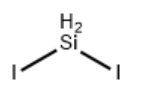
IdentificationPhysical DataSpectraRoute of Synthesis (ROS)Safety and HazardsOther Data
Identification
Product NameDiiodosilaneMolecular StructureCAS Registry Number 13760-02-6MDL NumberMFCD00075171Synonyms3-Pyridinamin;3-Pyridinamine;3-Pyridinamine;pyridin-3-amine;T6NJ CZ;3- Aminopyridine;3-Amino-pyridine;3-pyridylamine;Amino-3 pyridine;m-Aminopyridine;MS/MS-1064463;Pyridin-3-ylamine;Pyridine, 3-amino-;β-Aminopyridine462-08-8Molecular FormulaI2Si Molecular Weight281.894InChIInChI=1S/I2Si/c1-3-2 InChI KeyRNRZLEZABHZRSX-UHFFFAOYSA-N Isomeric SMILES(I)I
Patent InformationPatent IDTitlePublication DateJP2023/522969Method for preparing iodosilane and composition thereof2023 WO2017/201456PREPARATION OF SI-H CONTAINING IODOSILANES VIA HALIDE EXCHANGE REACTION2017
Physical Data
AppearanceColorless to Yellow to Orange to Pink to Faint Red Liquid
Melting Point, °C Solvent (Melting Point) -1
Boiling Point, °C149.5150
Density, g·cm-3Reference Temperature, °C2.72920.52.73202.74515.52.74615.12.760510.82.77272.7775.1
Spectra
No data available
Route of Synthesis (ROS)
Route of Synthesis (ROS) of CAS Diiodosilane CAS 13760-02-6
ConditionsYieldIn pentane at -70 - 35℃; for 16h; Temperature; Solvent; Inert atmosphere; Large scale;77%at 40℃; under 1277.21 - 2311.54 Torr; for 0.08h; Temperature;Experimental ProcedureThis example demonstrates a method of the invention in which dichlorosilane is converted to diiodosilane. (0079) A jacketed vertical stainless-steel tube, measuring 29 inches long with a diameter of 0.5 inches, was plumbed from the bottom outlet to a glass round bottom flask with a skin temperature maintained at 100 °C. The flask was equipped with a tap water condenser which was vented to a dry ice cooled stainless steel canister. The tube jacket was maintained at 40 °C by recirculating a temperature controlled fluid. The system was purged with nitrogen and the tube was loaded with 80 g of anhydrous lithium iodide. 402 g of dichlorosilane was fed to the top end of the tube at such a rate as to achieve a residence time inside of the tube of 4.8 minutes while maintaining a back pressure of 10-30 psig. Once the internal temperature of the eluent flask was within 5 °C of the skin temperature the mixture was transferred to a distillation apparatus consisting of a round bottom flask equipped with a magnetic stirrer, and fitted with an 8 inch column packed with glass packing. The distillation column was equipped with a tap water condenser. The pressure of the distillation system was reduced to 30 mmHg and the pot was heated until the temperature above the column began to rise indicating the complete removal of dichlorosilane. 45.3 g of diiodosilane was isolated from the distillation bottom in 99.7% purity as indicated by GC-TCD.
Safety and Hazards
No data available
Other Data
TransportationUnder the room temperature and away from lightHS CodeStorageUnder the room temperature and away from lightShelf Life1 yearMarket Price
DruglikenessLipinski rules componentMolecular Weight283.91logP2.237HBA0HBD0Matching Lipinski Rules4Veber rules componentPolar Surface Area (PSA)0Rotatable Bond (RotB)0Matching Veber Rules2
Use PatternDiiodosilane CAS#: 13760-02-6 can be used as coupling agents, surfactants, and catalysts.
https://www.chemwhat.com/diiodosilane-cas-13760-02-6/
Comments
Post a Comment